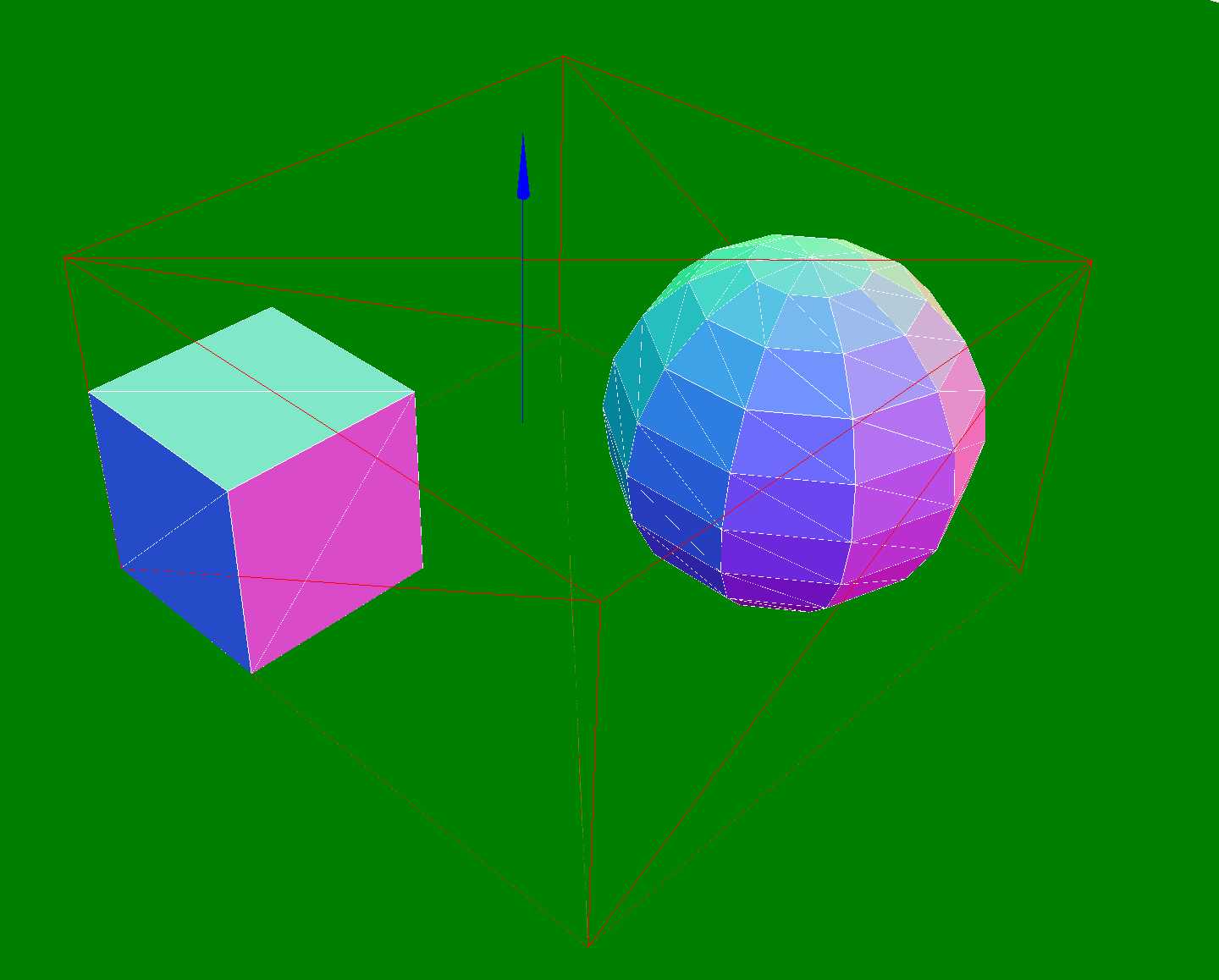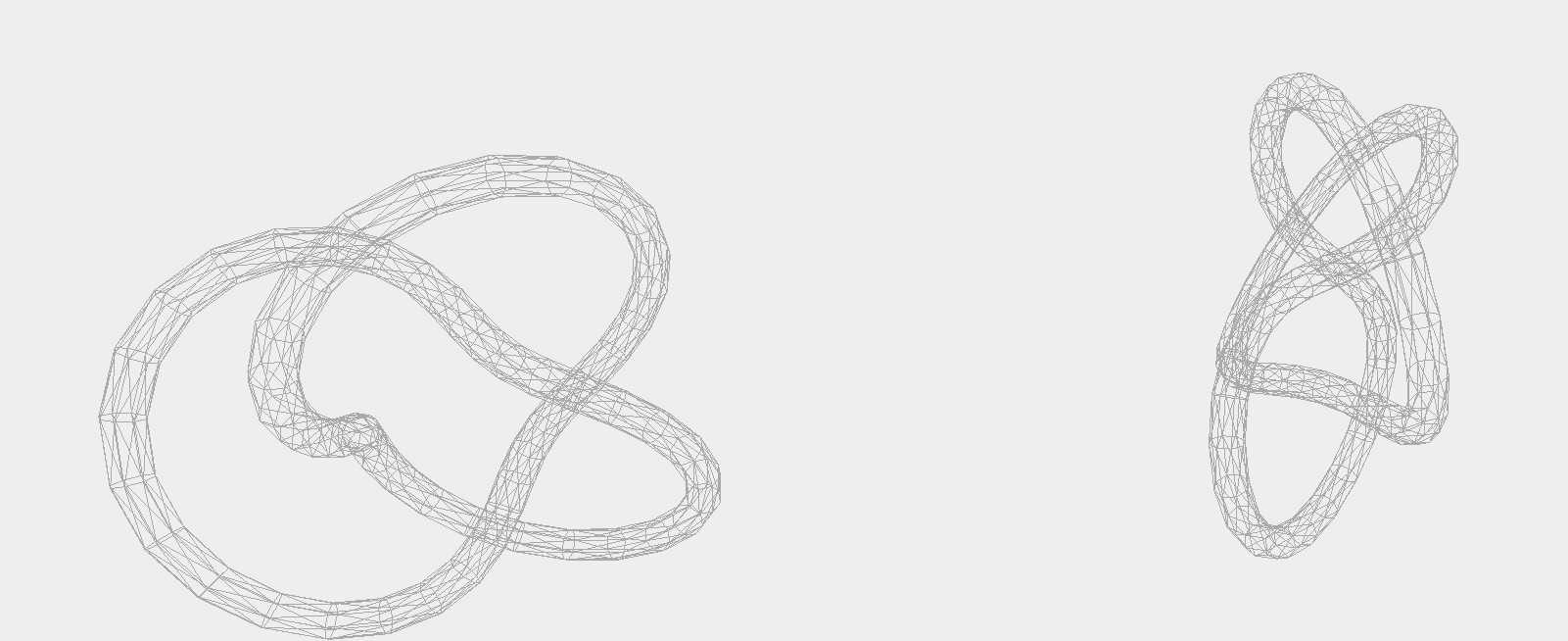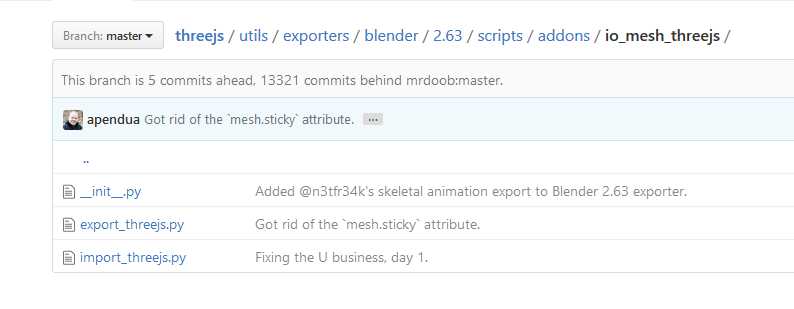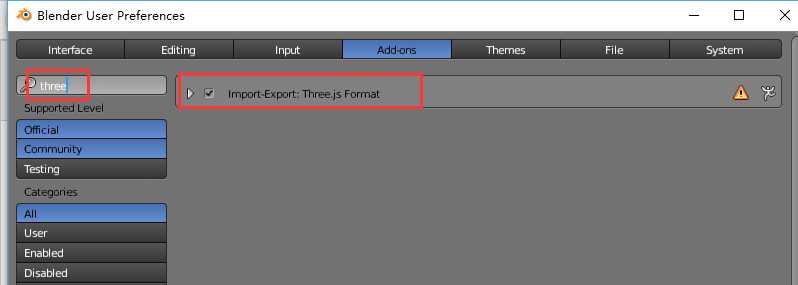标签:remes 验证 app exports 出图 计算 and spi load
本章的主要内容:
一, 通过Three.js自带的功能来组合和合并已有的几何体,创建出新的几何体
二, 从外部资源中加载网格和几何体
1 前面的章节中,我们学习到,一个几何体创建的网格,想使用多个材质的方法:
var mesh=THREE.SceneUtils.createMultiMaterialObject(geometry,[material1,,material2]);
看似一个网格中有一个几何体,多个材质,其实该网格拥有与材质数量相对应的几何体,每个几何体都对应一种材质,形成一个网格,我们得到的是包含多个网格的组
在下面的demo中,我们将创建一个网格组,该组包含多个网格,当这个组进行缩放,移动,旋转,变形的时候,组内的网格都会跟着变化
注意点1:创建组,将球体和立方体都添加到该组中
var group = new THREE.Group();group.add(sphereMesh);group.add(boxMesh)
注意点2:计算组的边界,生成一个边界无限大的立方体,对组以及组内子对象应用矩阵变换,得到组内子对象顶点改变后的坐标,复制子对象的每个顶点坐标,重新设置立方体的边界,参见函数setFromObject
注意点3:辅助线ArrowHelper,其参数的解读,dir:方向,默认是法向量;origin:开始的坐标位置;length:辅助线的长度;color:辅助线的颜色;headLength:头部的长度;headWidth:头部的宽度

<!DOCTYPE html> <html> <head> <title>Example 08.01 - Grouping</title> <script type="text/javascript" src="../libs/three.js"></script> <script type="text/javascript" src="../libs/stats.js"></script> <script type="text/javascript" src="../libs/dat.gui.js"></script> <style> body { /* set margin to 0 and overflow to hidden, to go fullscreen */ margin: 0; overflow: hidden; } </style> </head> <body> <div id="Stats-output"> </div> <!-- Div which will hold the Output --> <div id="WebGL-output"> </div> <!-- Javascript code that runs our Three.js examples --> <script type="text/javascript"> // once everything is loaded, we run our Three.js stuff. function init() { var stats = initStats(); // create a scene, that will hold all our elements such as objects, cameras and lights. var scene = new THREE.Scene(); // create a camera, which defines where we‘re looking at. var camera = new THREE.PerspectiveCamera(45, window.innerWidth / window.innerHeight, 0.1, 1000); // create a render and set the size var webGLRenderer = new THREE.WebGLRenderer(); webGLRenderer.setClearColor(new THREE.Color(0xEEEEEE, 1.0)); webGLRenderer.setSize(window.innerWidth, window.innerHeight); webGLRenderer.shadowMapEnabled = true; // add the sphere to the scene // position and point the camera to the center of the scene camera.position.x = 30; camera.position.y = 30; camera.position.z = 30; camera.lookAt(new THREE.Vector3(0, 0, 0)); var ground = new THREE.PlaneGeometry(100, 100, 50, 50); var groundMesh = THREE.SceneUtils.createMultiMaterialObject(ground, [new THREE.MeshBasicMaterial({wireframe: false, overdraw: true, color: 000000}), new THREE.MeshBasicMaterial({color: 0x00ff00, transparent: true, opacity: 0.5} ) ]); groundMesh.rotation.x = -0.5 * Math.PI; scene.add(groundMesh); // add the output of the renderer to the html element document.getElementById("WebGL-output").appendChild(webGLRenderer.domElement); // call the render function var step = 0.03; var sphere; var cube; var group; var bboxMesh; // setup the control gui var controls = new function () { // we need the first child, since it‘s a multimaterial this.cubePosX = 0; this.cubePosY = 3; this.cubePosZ = 10; this.spherePosX = 10; this.spherePosY = 5; this.spherePosZ = 0; this.groupPosX = 10; this.groupPosY = 5; this.groupPosZ = 0; this.grouping = false; this.rotate = false; this.groupScale = 1; this.cubeScale = 1; this.sphereScale = 1; this.redraw = function () { // remove the old plane //scene.remove(sphere); //scene.remove(cube); scene.remove(group); // create a new one sphere = createMesh(new THREE.SphereGeometry(5, 10, 10)); cube = createMesh(new THREE.BoxGeometry(6, 6, 6)); sphere.position.set(controls.spherePosX, controls.spherePosY, controls.spherePosZ); cube.position.set(controls.cubePosX, controls.cubePosY, controls.cubePosZ); // add it to the scene. // also create a group, only used for rotating group = new THREE.Group(); group.add(sphere); group.add(cube); scene.add(group); controls.positionBoundingBox(); //dir, origin, length, color, headLength, headWidth /*ArrowHelper的参数: dir:方向,默认是法向量 origin:开始的坐标位置 length:辅助线的长度 color:辅助线的颜色 headLength:头部的长度 headWidth:头部的宽度 */ var arrow = new THREE.ArrowHelper(new THREE.Vector3(0, 1, 0), group.position, 10, 0x0000ff); scene.add(arrow); }; this.positionBoundingBox = function () { scene.remove(bboxMesh); var box = setFromObject(group);//group中的子对象的坐标变换完毕后,获取到组group的新的边界立方体 var width = box.max.x - box.min.x; var height = box.max.y - box.min.y; var depth = box.max.z - box.min.z; //得到group立方体边界的宽高和深度,根据这些值,生成一个立方几何体 var bbox = new THREE.BoxGeometry(width, height, depth); bboxMesh = new THREE.Mesh(bbox, new THREE.MeshBasicMaterial({ color: "red", vertexColors: THREE.VertexColors, wireframeLinewidth: 2, wireframe: true })); scene.add(bboxMesh); bboxMesh.position.x = ((box.min.x + box.max.x) / 2); bboxMesh.position.y = ((box.min.y + box.max.y) / 2); bboxMesh.position.z = ((box.min.z + box.max.z) / 2); } }; var gui = new dat.GUI(); var sphereFolder = gui.addFolder("sphere"); sphereFolder.add(controls, "spherePosX", -20, 20).onChange(function (e) { sphere.position.x = e; //当球体的坐标发生变化时,应该重新计算组group的范围 //包含区域的最小矩形,该区域应在最小矩形内部 controls.positionBoundingBox() }); sphereFolder.add(controls, "spherePosZ", -20, 20).onChange(function (e) { sphere.position.z = e; controls.positionBoundingBox() }); sphereFolder.add(controls, "spherePosY", -20, 20).onChange(function (e) { sphere.position.y = e; controls.positionBoundingBox() }); sphereFolder.add(controls, "sphereScale", 0, 3).onChange(function (e) { sphere.scale.set(e, e, e); controls.positionBoundingBox() }); var cubeFolder = gui.addFolder("cube"); cubeFolder.add(controls, "cubePosX", -20, 20).onChange(function (e) { cube.position.x = e; controls.positionBoundingBox() }); cubeFolder.add(controls, "cubePosZ", -20, 20).onChange(function (e) { cube.position.z = e; controls.positionBoundingBox() }); cubeFolder.add(controls, "cubePosY", -20, 20).onChange(function (e) { cube.position.y = e; controls.positionBoundingBox() }); cubeFolder.add(controls, "cubeScale", 0, 3).onChange(function (e) { cube.scale.set(e, e, e); controls.positionBoundingBox() }); var cubeFolder = gui.addFolder("group"); cubeFolder.add(controls, "groupPosX", -20, 20).onChange(function (e) { group.position.x = e; controls.positionBoundingBox() }); cubeFolder.add(controls, "groupPosZ", -20, 20).onChange(function (e) { group.position.z = e; controls.positionBoundingBox() }); cubeFolder.add(controls, "groupPosY", -20, 20).onChange(function (e) { group.position.y = e; controls.positionBoundingBox() }); cubeFolder.add(controls, "groupScale", 0, 3).onChange(function (e) { group.scale.set(e, e, e); controls.positionBoundingBox() }); gui.add(controls, "grouping"); gui.add(controls, "rotate"); controls.redraw(); render(); function createMesh(geom) { // assign two materials var meshMaterial = new THREE.MeshNormalMaterial(); meshMaterial.side = THREE.DoubleSide; var wireFrameMat = new THREE.MeshBasicMaterial(); wireFrameMat.wireframe = true; // 创建一个多种材质的网格 var plane = THREE.SceneUtils.createMultiMaterialObject(geom, [meshMaterial, wireFrameMat]); return plane; } function render() { stats.update(); if (controls.grouping && controls.rotate) { group.rotation.y += step; } if (controls.rotate && !controls.grouping) { sphere.rotation.y += step; cube.rotation.y += step; } // controls.positionBoundingBox(); // render using requestAnimationFrame requestAnimationFrame(render); webGLRenderer.render(scene, camera); } function initStats() { var stats = new Stats(); stats.setMode(0); // 0: fps, 1: ms // Align top-left stats.domElement.style.position = ‘absolute‘; stats.domElement.style.left = ‘0px‘; stats.domElement.style.top = ‘0px‘; document.getElementById("Stats-output").appendChild(stats.domElement); return stats; } // http://jsfiddle.net/MREL4/ function setFromObject(object) { //Box3对象的构造函数.用来在三维空间内创建一个立方体边界对象 //参数min,max,如果没有参数min,max将立方体边界初始化为Infinity,无穷大 var box = new THREE.Box3(); var v1 = new THREE.Vector3(); //设置全局变换,object,即该demo中的group以及子对象都应用矩阵变换. object.updateMatrixWorld(true); //调用Box3.makeEmpty()方法,将立方体边界设置成无穷大. box.makeEmpty(); //然后遍历组group中的每个子对象 object.traverse(function (node) { //如果该子对象有几何体且几何体有顶点,则复制该几何体的每个顶点,然后对其进行矩阵变换 //矩阵变换后得到的新的坐标位置,再根据这些新的坐标设置group的边界 if (node.geometry !== undefined && node.geometry.vertices !== undefined) { var vertices = node.geometry.vertices; for (var i = 0, il = vertices.length; i < il; i++) { v1.copy(vertices[i]); v1.applyMatrix4(node.matrixWorld); //applyMatrix4方法通过传递变换矩阵matrix(旋转,缩放,移动等变换矩阵) //对当前立方体对象的8个角点,应用变换. box.expandByPoint(v1); //调用expandByPoint()方法重新设置立方体边界 } } }); return box; } }; window.onload = init; </script> </body> </html>
2
当页面中网格的数量很大的时候,性能就成了瓶颈
下图讲解:FPS:每秒执行多少次,
左侧的是未使用merge,右侧是使用merge
从图中可以看出,未使用merge的时候,一秒钟执行了23次刷新,使用merge后,一秒钟执行了50次刷新,性能得到了提高

这里使用THREE.GeometryUtils.merge函数,将多个几何体合并起来,创建一个联合体,将会提高性能,
缺点:我们只能得到一个几何体,所以不能为每个几何体添加材质,并且失去了对每个对象的单独控制,想要移动,旋转,删除,缩放某一个几何体是不可能的
<!DOCTYPE html> <html> <head> <title>Example 08.02 - Merge objects</title> <script type="text/javascript" src="../libs/three.js"></script> <script type="text/javascript" src="../libs/stats.js"></script> <script type="text/javascript" src="../libs/dat.gui.js"></script> <style> body { /* set margin to 0 and overflow to hidden, to go fullscreen */ margin: 0; overflow: hidden; } </style> </head> <body> <div id="Stats-output"> </div> <!-- Div which will hold the Output --> <div id="WebGL-output"> </div> <!-- Javascript code that runs our Three.js examples --> <script type="text/javascript"> // once everything is loaded, we run our Three.js stuff. function init() { var stats = initStats(); // create a scene, that will hold all our elements such as objects, cameras and lights. var scene = new THREE.Scene(); // create a camera, which defines where we‘re looking at. var camera = new THREE.PerspectiveCamera(45, window.innerWidth / window.innerHeight, 1, 500); // create a render and set the size var renderer = new THREE.WebGLRenderer(); renderer.setClearColor(new THREE.Color(0x00000, 1.0)); renderer.setSize(window.innerWidth, window.innerHeight); renderer.shadowMapEnabled = true; // position and point the camera to the center of the scene camera.position.x = 0; camera.position.y = 40; camera.position.z = 50; camera.lookAt(scene.position); // add the output of the renderer to the html element document.getElementById("WebGL-output").appendChild(renderer.domElement); // call the render function var step = 0; var cubeMaterial = new THREE.MeshNormalMaterial({color: 0x00ff00, transparent: true, opacity: 0.5}); var controls = new function () { this.cameraNear = camera.near; this.cameraFar = camera.far; this.rotationSpeed = 0.02; this.combined = false; this.numberOfObjects = 500; this.redraw = function () { var toRemove = []; scene.traverse(function (e) { if (e instanceof THREE.Mesh) toRemove.push(e); }); toRemove.forEach(function (e) { scene.remove(e) }); // add a large number of cubes if (controls.combined) { var geometry = new THREE.Geometry(); for (var i = 0; i < controls.numberOfObjects; i++) { var cubeMesh = addcube(); cubeMesh.updateMatrix(); geometry.merge(cubeMesh.geometry, cubeMesh.matrix); } scene.add(new THREE.Mesh(geometry, cubeMaterial)); } else { for (var i = 0; i < controls.numberOfObjects; i++) { scene.add(controls.addCube()); } } }; this.addCube = addcube; this.outputObjects = function () { console.log(scene.children); } }; var gui = new dat.GUI(); gui.add(controls, ‘numberOfObjects‘, 0, 20000); gui.add(controls, ‘combined‘).onChange(controls.redraw); gui.add(controls, ‘redraw‘); controls.redraw(); render(); var rotation = 0; function addcube() { var cubeSize = 1.0; var cubeGeometry = new THREE.BoxGeometry(cubeSize, cubeSize, cubeSize); var cube = new THREE.Mesh(cubeGeometry, cubeMaterial); cube.castShadow = true; // position the cube randomly in the scene cube.position.x = -60 + Math.round((Math.random() * 100)); cube.position.y = Math.round((Math.random() * 10)); cube.position.z = -150 + Math.round((Math.random() * 175)); // add the cube to the scene return cube; } function render() { rotation += 0.005; stats.update(); // scene.rotation.x+=0.02; // rotate the cubes around its axes // scene.traverse(function(e) { // if (e instanceof THREE.Mesh ) { // // e.rotation.x+=controls.rotationSpeed; // e.rotation.y+=controls.rotationSpeed; // e.rotation.z+=controls.rotationSpeed; // } // }); camera.position.x = Math.sin(rotation) * 50; // camera.position.y = Math.sin(rotation) * 40; camera.position.z = Math.cos(rotation) * 50; camera.lookAt(scene.position); // render using requestAnimationFrame requestAnimationFrame(render); renderer.render(scene, camera); } function initStats() { var stats = new Stats(); stats.setMode(0); // 0: fps, 1: ms // Align top-left stats.domElement.style.position = ‘absolute‘; stats.domElement.style.left = ‘0px‘; stats.domElement.style.top = ‘0px‘; document.getElementById("Stats-output").appendChild(stats.domElement); return stats; } } window.onload = init; </script> </body> </html>
3 从外部引入资源加载几何体---方式一JSON
首先,我们先把我们前面绘制的网格对象保存为JSON格式,然后再在另外一个文件中引入该JSON文件,进行解析绘制
var mesh=new THREE.Mesh(geo,material); var json= mesh.toJSON(); //将mesh网格保存为JSON格式 //将json绘制为网格 var loader = new THREE.ObjectLoader(); loadedMesh = loader.parse(json); loadedMesh.position.x -= 50; scene.add(loadedMesh);

<!DOCTYPE html> <html> <head> <title>Example 08.03 - Save & Load</title> <script type="text/javascript" src="../libs/three.js"></script> <script type="text/javascript" src="../libs/stats.js"></script> <script type="text/javascript" src="../libs/dat.gui.js"></script> <style> body { /* set margin to 0 and overflow to hidden, to go fullscreen */ margin: 0; overflow: hidden; } </style> </head> <body> <div id="Stats-output"> </div> <!-- Div which will hold the Output --> <div id="WebGL-output"> </div> <!-- Javascript code that runs our Three.js examples --> <script type="text/javascript"> // once everything is loaded, we run our Three.js stuff. function init() { var stats = initStats(); // create a scene, that will hold all our elements such as objects, cameras and lights. var scene = new THREE.Scene(); // create a camera, which defines where we‘re looking at. var camera = new THREE.PerspectiveCamera(45, window.innerWidth / window.innerHeight, 0.1, 1000); // create a render and set the size var webGLRenderer = new THREE.WebGLRenderer(); webGLRenderer.setClearColor(new THREE.Color(0xEEEEEE, 1.0)); webGLRenderer.setSize(window.innerWidth, window.innerHeight); webGLRenderer.shadowMapEnabled = true; var knot = createMesh(new THREE.TorusKnotGeometry(10, 1, 64, 8, 2, 3, 1)); // add the sphere to the scene scene.add(knot); // position and point the camera to the center of the scene camera.position.x = -30; camera.position.y = 40; camera.position.z = 50; camera.lookAt(new THREE.Vector3(-20, 0, 0)); // add the output of the renderer to the html element document.getElementById("WebGL-output").appendChild(webGLRenderer.domElement); // call the render function var step = 0; var json; var loadedMesh; // setup the control gui var controls = new function () { console.log(knot.geometry.parameters); // we need the first child, since it‘s a multimaterial this.radius = knot.geometry.parameters.radius; this.tube = 0.3; this.radialSegments = knot.geometry.parameters.radialSegments; this.tubularSegments = knot.geometry.parameters.tubularSegments; this.p = knot.geometry.parameters.p; this.q = knot.geometry.parameters.q; this.heightScale = knot.geometry.parameters.heightScale; this.redraw = function () { // remove the old plane scene.remove(knot); // create a new one knot = createMesh(new THREE.TorusKnotGeometry(controls.radius, controls.tube, Math.round(controls.radialSegments), Math.round(controls.tubularSegments), Math.round(controls.p), Math.round(controls.q), controls.heightScale)); // add it to the scene. scene.add(knot); }; this.save = function () { json = knot.toJSON(); }; this.load = function () { scene.remove(loadedMesh); if (json) { var loader = new THREE.ObjectLoader(); loadedMesh = loader.parse(json); loadedMesh.position.x -= 50; scene.add(loadedMesh); } } }; var gui = new dat.GUI(); var ioGui = gui.addFolder(‘Save & Load‘); ioGui.add(controls, ‘save‘).onChange(controls.save); ioGui.add(controls, ‘load‘).onChange(controls.load); var meshGui = gui.addFolder(‘mesh‘); meshGui.add(controls, ‘radius‘, 0, 40).onChange(controls.redraw); meshGui.add(controls, ‘tube‘, 0, 40).onChange(controls.redraw); meshGui.add(controls, ‘radialSegments‘, 0, 400).step(1).onChange(controls.redraw); meshGui.add(controls, ‘tubularSegments‘, 1, 20).step(1).onChange(controls.redraw); meshGui.add(controls, ‘p‘, 1, 10).step(1).onChange(controls.redraw); meshGui.add(controls, ‘q‘, 1, 15).step(1).onChange(controls.redraw); meshGui.add(controls, ‘heightScale‘, 0, 5).onChange(controls.redraw); render(); function createMesh(geom) { // assign two materials var meshMaterial = new THREE.MeshBasicMaterial({ vertexColors: THREE.VertexColors, wireframe: true, wireframeLinewidth: 2, color: 0xaaaaaa }); meshMaterial.side = THREE.DoubleSide; // create a multimaterial var mesh = new THREE.Mesh(geom, meshMaterial); return mesh; } function render() { stats.update(); knot.rotation.y = step += 0.01; // render using requestAnimationFrame requestAnimationFrame(render); webGLRenderer.render(scene, camera); } function initStats() { var stats = new Stats(); stats.setMode(0); // 0: fps, 1: ms // Align top-left stats.domElement.style.position = ‘absolute‘; stats.domElement.style.left = ‘0px‘; stats.domElement.style.top = ‘0px‘; document.getElementById("Stats-output").appendChild(stats.domElement); return stats; } } window.onload = init; </script> </body> </html>
3.2 将场景保存为JSON格式
注意该demo需要引入SceneExporter.js和SceneLoader.js文件
//生成一个场景输出对象 var exporter = new THREE.SceneExporter(); //该对象将场景进行格式化为JSON格式 var sceneJson = JSON.stringify(exporter.parse(scene));
//生成一个场景载入对象 var sceneLoader = new THREE.SceneLoader(); //将json格式的场景传递给场景载入对象,格式化为场景 sceneLoader.parse(JSON.parse(json), function (e) { scene = e.scene; }, ‘.‘);
<!DOCTYPE html> <html> <head> <title>Example 08.04 - Load and save scene</title> <script type="text/javascript" src="../libs/three.js"></script> <script type="text/javascript" src="../libs/SceneLoader.js"></script> <script type="text/javascript" src="../libs/SceneExporter.js"></script> <script type="text/javascript" src="../libs/stats.js"></script> <script type="text/javascript" src="../libs/dat.gui.js"></script> <style> body { /* set margin to 0 and overflow to hidden, to go fullscreen */ margin: 0; overflow: hidden; } </style> </head> <body> <div id="Stats-output"> </div> <!-- Div which will hold the Output --> <div id="WebGL-output"> </div> <!-- Javascript code that runs our Three.js examples --> <script type="text/javascript"> // once everything is loaded, we run our Three.js stuff. function init() { var stats = initStats(); // create a scene, that will hold all our elements such as objects, cameras and lights. var scene = new THREE.Scene(); // create a camera, which defines where we‘re looking at. var camera = new THREE.PerspectiveCamera(45, window.innerWidth / window.innerHeight, 0.1, 1000); // create a render and set the size var renderer = new THREE.WebGLRenderer(); renderer.setClearColor(new THREE.Color(0xEEEEEE, 1.0)); renderer.setSize(window.innerWidth, window.innerHeight); // renderer.shadowMapEnabled = true; // create the ground plane var planeGeometry = new THREE.PlaneGeometry(60, 20, 1, 1); var planeMaterial = new THREE.MeshLambertMaterial({color: 0xffffff}); var plane = new THREE.Mesh(planeGeometry, planeMaterial); // plane.receiveShadow = true; // rotate and position the plane plane.rotation.x = -0.5 * Math.PI; plane.position.x = 15; plane.position.y = 0; plane.position.z = 0; // add the plane to the scene scene.add(plane); // create a cube var cubeGeometry = new THREE.BoxGeometry(4, 4, 4); var cubeMaterial = new THREE.MeshLambertMaterial({color: 0xff0000}); var cube = new THREE.Mesh(cubeGeometry, cubeMaterial); // cube.castShadow = true; // position the cube cube.position.x = -4; cube.position.y = 3; cube.position.z = 0; // add the cube to the scene scene.add(cube); var sphereGeometry = new THREE.SphereGeometry(4, 20, 20); var sphereMaterial = new THREE.MeshLambertMaterial({color: 0x7777ff}); var sphere = new THREE.Mesh(sphereGeometry, sphereMaterial); // position the sphere sphere.position.x = 20; sphere.position.y = 0; sphere.position.z = 2; // sphere.castShadow=true; // add the sphere to the scene scene.add(sphere); // position and point the camera to the center of the scene camera.position.x = -30; camera.position.y = 40; camera.position.z = 30; camera.lookAt(scene.position); // add subtle ambient lighting var ambientLight = new THREE.AmbientLight(0x0c0c0c); scene.add(ambientLight); // add spotlight for the shadows var spotLight = new THREE.PointLight(0xffffff); spotLight.position.set(-40, 60, -10); // spotLight.castShadow = true; scene.add(spotLight); // add the output of the renderer to the html element document.getElementById("WebGL-output").appendChild(renderer.domElement); // call the render function var step = 0; var controls = new function () { this.exportScene = function () { //生成一个场景输出对象 var exporter = new THREE.SceneExporter(); //该对象将场景进行格式化为JSON格式 var sceneJson = JSON.stringify(exporter.parse(scene)); localStorage.setItem(‘scene‘, sceneJson); }; this.clearScene = function () { scene = new THREE.Scene(); }; this.importScene = function () { var json = (localStorage.getItem(‘scene‘)); //生成一个场景载入对象 var sceneLoader = new THREE.SceneLoader(); //将json格式的场景传递给场景载入对象,格式化为场景 sceneLoader.parse(JSON.parse(json), function (e) { scene = e.scene; }, ‘.‘); } }; var gui = new dat.GUI(); gui.add(controls, "exportScene"); gui.add(controls, "clearScene"); gui.add(controls, "importScene"); render(); function render() { stats.update(); // rotate the cube around its axes // render using requestAnimationFrame requestAnimationFrame(render); renderer.render(scene, camera); } function initStats() { var stats = new Stats(); stats.setMode(0); // 0: fps, 1: ms // Align top-left stats.domElement.style.position = ‘absolute‘; stats.domElement.style.left = ‘0px‘; stats.domElement.style.top = ‘0px‘; document.getElementById("Stats-output").appendChild(stats.domElement); return stats; } } window.onload = init; </script> </body> </html>
3.3 先使用Blender软件进行建模,建模完成后,将该模型导出成three.js可以识别的js文件格式,然后再将该js引入进行重新绘制
准备工作:
准备工作1:下载安装Blender软件:https://www.blender.org/download/
准备工作2:下载Three.js的发布包:https://github.com/timoxley/threejs,将io_mesh_threejs文件夹复制到Blender的安装目录:C:\Program Files\Blender Foundation\Blender\2.78\scripts\addons

准备工作3:激活导出器
File|User Preferences|搜索框输入three|右侧出现Import-export three.js Format|勾选复选框激活
准备工作4:验证three.js导出器是否激活成功:File|Export|Three.js(.js)
准备工作5:使用Blender建模,再将模型保存为*.js


准备工作6:Blender软件导出的js文件中,有些材质是有图片的,所以我们在导出的js文件的同时还要导出图片,并保证图片和js文件里面的路径已经名称一致
准备工作完成,下面我们将使用导出的*.js和*.jpg在网页中绘制图形


代码部分:
<!DOCTYPE html> <html> <head> <title>Example 08.05 - Load blender model </title> <script type="text/javascript" src="../libs/three.js"></script> <script type="text/javascript" src="../libs/stats.js"></script> <script type="text/javascript" src="../libs/dat.gui.js"></script> <style> body { /* set margin to 0 and overflow to hidden, to go fullscreen */ margin: 0; overflow: hidden; } </style> </head> <body> <div id="Stats-output"> </div> <!-- Div which will hold the Output --> <div id="WebGL-output"> </div> <!-- Javascript code that runs our Three.js examples --> <script type="text/javascript"> // once everything is loaded, we run our Three.js stuff. function init() { var stats = initStats(); // create a scene, that will hold all our elements such as objects, cameras and lights. var scene = new THREE.Scene(); // create a camera, which defines where we‘re looking at. var camera = new THREE.PerspectiveCamera(45, window.innerWidth / window.innerHeight, 0.1, 1000); // create a render and set the size var webGLRenderer = new THREE.WebGLRenderer(); webGLRenderer.setClearColor(new THREE.Color(0xEEEEEE, 1.0)); webGLRenderer.setSize(window.innerWidth, window.innerHeight); webGLRenderer.shadowMapEnabled = true; // position and point the camera to the center of the scene camera.position.x = -30; camera.position.y = 40; camera.position.z = 50; camera.lookAt(new THREE.Vector3(0, 10, 0)); // add spotlight for the shadows var spotLight = new THREE.SpotLight(0xffffff); spotLight.position.set(0, 50, 30); spotLight.intensity = 2; scene.add(spotLight); // add the output of the renderer to the html element document.getElementById("WebGL-output").appendChild(webGLRenderer.domElement); // call the render function var step = 0; // setup the control gui var controls = new function () { // we need the first child, since it‘s a multimaterial }; var gui = new dat.GUI(); var mesh; var loader = new THREE.JSONLoader(); //loader.load(url,callback); loader.load(‘../assets/models/misc_chair01.js‘, function (geometry, mat) { mesh = new THREE.Mesh(geometry, mat[0]); mesh.scale.x = 15; mesh.scale.y = 15; mesh.scale.z = 15; scene.add(mesh); }, ‘../assets/models/‘); render(); function render() { stats.update(); if (mesh) { mesh.rotation.y += 0.02; } // render using requestAnimationFrame requestAnimationFrame(render); webGLRenderer.render(scene, camera); } function initStats() { var stats = new Stats(); stats.setMode(0); // 0: fps, 1: ms // Align top-left stats.domElement.style.position = ‘absolute‘; stats.domElement.style.left = ‘0px‘; stats.domElement.style.top = ‘0px‘; document.getElementById("Stats-output").appendChild(stats.domElement); return stats; } } window.onload = init; </script> </body> </html>
3.4 先使用Blender软件进行建模,建模完成后,将该模型导出成three.js可以识别的OBJ和MTL文件格式,然后再将其引入进行重新绘制
理论解释:OBJ格式和MTL格式是相互配合使用的,OBJ文件定义了几何体的格式 ,MTL定义了所使用的材质
准备工作:同Blender导出*.js文件一样,1 安装Blender软件,进行建模;2 导入OBJ/MTL下载包,激活导出器;3 导出模型文件 4 页面中引入OBJLoader和MTLLoader
<!DOCTYPE html> <html> <head> <title>Example 08.07 - Load OBJ and MTL </title> <script type="text/javascript" src="../libs/three.js"></script> <script type="text/javascript" src="../libs/OBJLoader.js"></script> <script type="text/javascript" src="../libs/MTLLoader.js"></script> <script type="text/javascript" src="../libs/OBJMTLLoader.js"></script> <script type="text/javascript" src="../libs/stats.js"></script> <script type="text/javascript" src="../libs/dat.gui.js"></script> <style> body { /* set margin to 0 and overflow to hidden, to go fullscreen */ margin: 0; overflow: hidden; } </style> </head> <body> <div id="Stats-output"> </div> <!-- Div which will hold the Output --> <div id="WebGL-output"> </div> <!-- Javascript code that runs our Three.js examples --> <script type="text/javascript"> // once everything is loaded, we run our Three.js stuff. function init() { var stats = initStats(); // create a scene, that will hold all our elements such as objects, cameras and lights. var scene = new THREE.Scene(); // create a camera, which defines where we‘re looking at. var camera = new THREE.PerspectiveCamera(45, window.innerWidth / window.innerHeight, 0.1, 1000); // create a render and set the size var webGLRenderer = new THREE.WebGLRenderer(); webGLRenderer.setClearColor(new THREE.Color(0xaaaaff, 1.0)); webGLRenderer.setSize(window.innerWidth, window.innerHeight); webGLRenderer.shadowMapEnabled = true; // position and point the camera to the center of the scene camera.position.x = -30; camera.position.y = 40; camera.position.z = 50; camera.lookAt(new THREE.Vector3(0, 10, 0)); // add spotlight for the shadows var spotLight = new THREE.SpotLight(0xffffff); spotLight.position.set(0, 40, 30); spotLight.intensity = 2; scene.add(spotLight); // add the output of the renderer to the html element document.getElementById("WebGL-output").appendChild(webGLRenderer.domElement); // call the render function var step = 0; // setup the control gui var controls = new function () { // we need the first child, since it‘s a multimaterial }; var gui = new dat.GUI(); var mesh; var loader = new THREE.OBJMTLLoader(); loader.load(‘../assets/models/butterfly.obj‘, ‘../assets/models/butterfly.mtl‘, function (object) { // configure the wings var wing2 = object.children[5].children[0]; var wing1 = object.children[4].children[0]; wing1.material.opacity = 0.6; wing1.material.transparent = true; wing1.material.depthTest = false; wing1.material.side = THREE.DoubleSide; wing2.material.opacity = 0.6; wing2.material.depthTest = false; wing2.material.transparent = true; wing2.material.side = THREE.DoubleSide; object.scale.set(140, 140, 140); mesh = object; scene.add(mesh); object.rotation.x = 0.2; object.rotation.y = -1.3; }); render(); function render() { stats.update(); if (mesh) { mesh.rotation.y += 0.006; } // render using requestAnimationFrame requestAnimationFrame(render); webGLRenderer.render(scene, camera); } function initStats() { var stats = new Stats(); stats.setMode(0); // 0: fps, 1: ms // Align top-left stats.domElement.style.position = ‘absolute‘; stats.domElement.style.left = ‘0px‘; stats.domElement.style.top = ‘0px‘; document.getElementById("Stats-output").appendChild(stats.domElement); return stats; } } window.onload = init; </script> </body> </html>
3.5 加载Collada模型
理论解释:Collada模型是定义的场景,不仅定义了几何体,定义了材质,还定义了光源
准备工作:1 下载安装Blender软件,如果已经安装忽略此步骤,进行建模;2 激活导出器,如果已经有的话,此步骤省略;3 导出模型文件 4 页面中引入ColladaLoader

关键代码:
var loader = new THREE.ColladaLoader(); var mesh; loader.load("../assets/models/dae/Truck_dae.dae", function (result) { mesh = result.scene.children[0].children[0].clone(); //由于Collada模型定义的是场景,因此不仅包含几何体,材质还有光源等 //因此此处我们想引入具体的某个网格,需要console.log(result),确定具体网格再添加到场景中 mesh.scale.set(4, 4, 4); scene.add(mesh); });
3.6 加载STL,CTM,VTK,PDB,PLY模型
var loader = new THREE.STLLoader(); var group = new THREE.Object3D(); loader.load("../assets/models/SolidHead_2_lowPoly_42k.stl", function (geometry) { console.log(geometry); var mat = new THREE.MeshLambertMaterial({color: 0x7777ff}); group = new THREE.Mesh(geometry, mat); group.rotation.x = -0.5 * Math.PI; group.scale.set(0.6, 0.6, 0.6); scene.add(group); });
var loader = new THREE.CTMLoader(); var group = new THREE.Object3D(); loader.load("../assets/models/auditt_wheel.ctm", function (geometry) { var mat = new THREE.MeshLambertMaterial({color: 0xff8888}); group = new THREE.Mesh(geometry, mat); group.scale.set(20, 20, 20); scene.add(group); }, {});
var loader = new THREE.VTKLoader(); var group = new THREE.Object3D(); loader.load("../assets/models/moai_fixed.vtk", function (geometry) { var mat = new THREE.MeshLambertMaterial({color: 0xaaffaa}); group = new THREE.Mesh(geometry, mat); group.scale.set(9, 9, 9); scene.add(group); });
var loader = new THREE.PDBLoader(); var group = new THREE.Object3D(); loader.load("../assets/models/aspirin.pdb", function (geometry, geometryBonds) { //geometry是标识原子的位置 geometryBonds定义了原子之间的键 var i = 0; geometry.vertices.forEach(function (position) { var sphere = new THREE.SphereGeometry(0.2); var material = new THREE.MeshPhongMaterial({color: geometry.colors[i++]}); var mesh = new THREE.Mesh(sphere, material); mesh.position.copy(position); group.add(mesh); }); for (var j = 0; j < geometryBonds.vertices.length; j += 2) { var path = new THREE.SplineCurve3([geometryBonds.vertices[j], geometryBonds.vertices[j + 1]]); var tube = new THREE.TubeGeometry(path, 1, 0.04); var material = new THREE.MeshPhongMaterial({color: 0xcccccc}); var mesh = new THREE.Mesh(tube, material); group.add(mesh); } scene.add(group); });
var loader = new THREE.PLYLoader();//创建粒子系统 var group = new THREE.Object3D(); loader.load("../assets/models/test.ply", function (geometry) { var material = new THREE.PointCloudMaterial({ color: 0xffffff, size: 0.4, opacity: 0.6, transparent: true, blending: THREE.AdditiveBlending, map: generateSprite() }); group = new THREE.PointCloud(geometry, material); group.sortParticles = true; scene.add(group); });
| 模型格式 | 描述 |
| JSON | JSON不是一种正式的格式,但是很好用 |
| OBJ,MTL | OBJ定义的是几何体,MTL定义的是材质 |
| Collada | 使用较为广泛的格式,几乎所有的三维软件和渲染引擎都支持这种格式 |
| STL | 立体成型术,三维打印机的模型文件就是STL |
| CTM | CTM格式用来压缩保存3D网格的三角面片 |
| PDB |
蛋白质数据银行创建的一种格式,用来定义蛋白质的形状, 参数geometry的各个顶点标识的是各个原子的位置,geometryBonds:是各个原子之间的键 |
| PLY | 用来保存3D扫描仪的数据,该模型建立的是一个粒子系统,而不是网格 |
| VTK | vISUALIZATION Toolkit定义的文件格式,three.js支持旧版的ASCII版本的 |
Three.js开发指南---创建,加载高级网格和几何体(第八章)
标签:remes 验证 app exports 出图 计算 and spi load
原文地址:http://www.cnblogs.com/amy2011/p/6358527.html